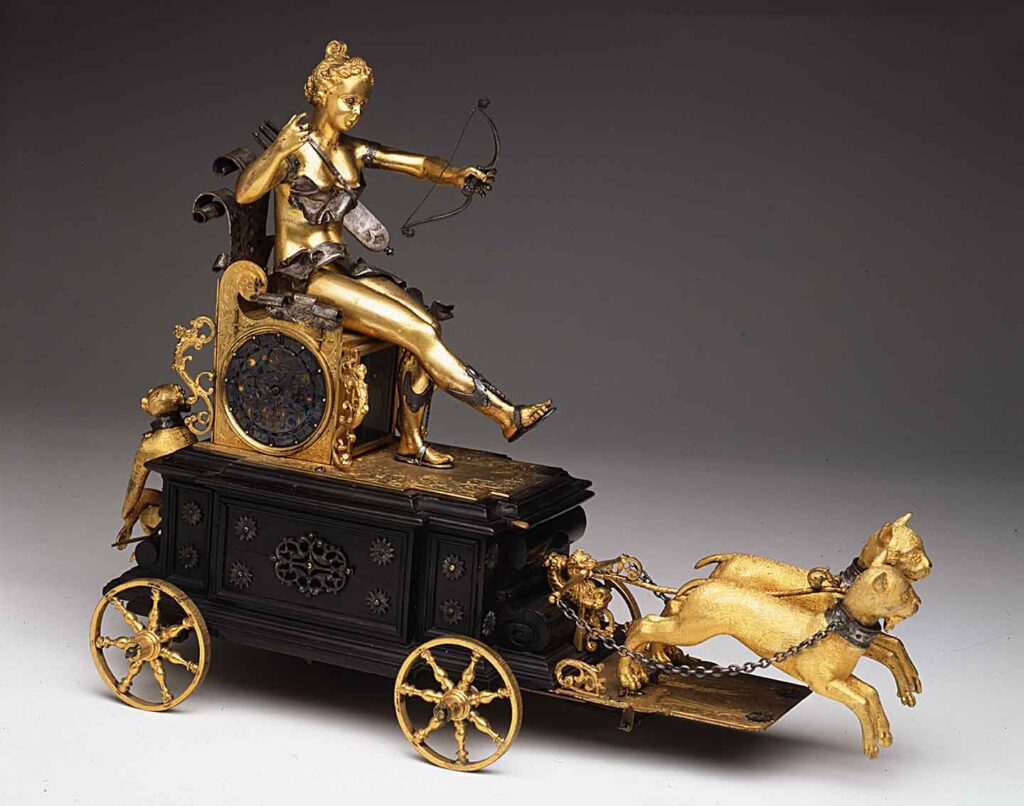Automaton with Clock known as “The Chariot of Diana”
Augsburg , 1610
Description

The most sophisticated Renaissance clocks, many of which include automata, were made for the wunderkammer (wonder chambers) of northern European nobility by skilled craftsmen in Augsburg, southern Germany. Diana’s chariot is a table automaton (Tischautomat) intended to amaze guests by moving from diner to diner. The young woman, Diana, goddess of the hunt, sits on a gilded throne, finely engraved on the side sides, where two dials of a clock (right) and chime (left) in silver with translucent champlevé enamels with decorative flower and bird motifs (now partially missing) reside. The clock hidden inside the throne makes Diana’s eyes move. The edges of the throne are decorated with scrolls with small caryatids made of cast bronze.
The back of the throne is decorated with a silver curled scroll motif, as are the side rails. The throne is mounted on a gilt brass plate engraved with grotesque motifs, attached in turn to the shaft of the chariot. The latter, made of ebonized wood, is adorned on its sides with silver rosettes and fastigi and is fitted with four gilded bronze wheels. At the back of the chariot, on a dais, sits a monkey with a silver collar and a fruit in his right hand. Tied to the front of the chariot, by means of two silver chains attached to the collars, are two felines(lionesses or panthers) in the act of leaping forward,with their hind legs hinged to a sheet of gilt brass engraved with floral motifs. The three animals are gilded bronze, made by casting; the coats are finely worked to create the effect of fur, and the heads are separable from the body.
The chains terminate on a rudder held by a small rampant lion. The automaton contained within the shaft moves the chariot forward, swinging the bodies of the two felines in alternating motion, thus giving the impression that they are pulling the chariot, and rotates their heads, along with that of the monkey seated at the back. The clock and chime mechanisms are contained in the throne seat, visible through glass panes mounted on the front and back faces of the throne itself. The winding holes of the clock and chime are contained in the left quadrant; the winding hole of the chariot automaton is located on the right side of the shaft.
The silver draperies covering Diana’s breast and side, as well as the curled scrolls on the back and side rails of the throne, roughly fixed and of coarser execution, are probably later additions. The automaton was presented by Gian Giacomo Poldi Pezzoli at the 1874 Historical Exhibition of Industrial Art in Milan, in whose catalog the object is mentioned in the “Small Furniture” section with the following description: “Fireplace clock; German work of the 16th century; representing Diana on a chariot drawn by lions.” In the inventory following Poldi Pezzoli’s death in 1879, the estimated value of the object was 2,000 lire. Maurice – Mayr (1980) reports three other examples of this particular type of automaton,two of which are in public collections (HistoriskaMuseet in Stockholm, Yale University Art Galleryin Boston). There is a typically Germanic tradition of producing board games(Tafelspiel) or potori games (Trinkspiel) related to the celebration of the hunt, in which the absolute protagonist is Diana. Many of these automata were actually liquid vessels that, moved by mechanisms hidden in the base, were used on the tables.
Data Sheet
Author
Augsburg
Date
1610
Material and technique
bronze, brass, silver, ebony
Measures
305 mm x 410 mm x 170 mm
Acquisition
Gian Giacomo Poldi Pezzoli bequest, 1879
Inventory number
1149
collection
Clocks and watches
About 500 pieces form the most important antique horology collection in Italy. It was enriched thanks to donations, as the ones by Bruno Falck, Luigi Delle Piane, Alfredo Zanotelli, Angelo Reina. The collection illustrates the history of European clockmaking from the 16th to the 19th century. It includes Renaissance and Baroque table clocks as well as German, English, French and Swiss ones. Extraordinary items not only for their mechanisms but also for their precious case’s decorations.
